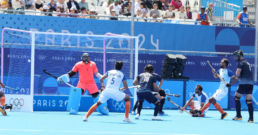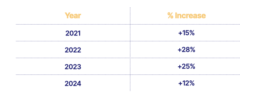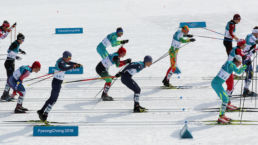The Olympics plays a crucial role for most International Federations (IFs) in promoting their sport and engaging their fans. In 2024, the Games drove significant digital growth for many IFs (+95% overall) and increased engagement (+75%) compared to 2023.
Despite this, the Olympics had less impact for the biggest five IFs which saw declines in engagement (-32%) and growth (-39%) vs 2023, a year when their flagship events delivered stronger results without Olympic competition.
This highlights an important shift: while the Olympics boosts the visibility of most IFs, it is not the ultimate stage for all of them. As minds begin to focus on Milano Cortina 2026 and LA28, IFs need to refine their strategies to sustain impact beyond the Games.
This article draws on insights from the SportOnSocial International Federations 2025 Report and outlines key strategies for long-term digital success.
Content & distribution strategy

Observation
Paris 2024 offered athletes greater freedom to share content, giving fans exclusive behind-the-scenes access to the Games and deepening their connection to the event.
And yet IFs still faced content restrictions which limited their ability to use in-competition footage. This posed additional challenges in sustaining engagement during the Games and prolonging momentum afterwards.
Evidence for this can be found in the drop in TikTok engagement during Paris 2024: its share of total engagements fell from 19% to 9% despite a +244% increase in carousel posts.
In contrast, Instagram’s share grew from 71% to 76%, highlighting its strength as a platform where federations can drive engagement through consistent imagery, unlike TikTok, which relies more on video content.
Some IFs overcame this by leveraging archive content, thus contributing to strong video performance aligned with IOC benchmarks.
Takeaway
IFs should develop a storytelling strategy that spans the entire Olympic cycle. A robust visual and editorial identity, combined with evergreen content, will help retain engagement outside event-driven spikes. The objective is to embed the sport into fans’ daily digital habits to ensure year-round relevance.
Audience development & engagement
Observation
IFs face a trade-off between deepening engagement with existing fans and attracting new ones. Recent data shows audience growth is slowing, with total follower growth across IFs at its lowest since 2021.

Larger IFs have been hit hardest, with a -49% decline in growth rate vs 2023. This suggests that IFs will struggle to attract new fans unless they adopt a fresh approach.
Takeaway
A successful strategy needs to balance community-building with expansion. IFs have got to use social storytelling to turn casual followers into dedicated fans by focusing on authenticity and cultural relevance. Rather than merely broadcasting results, the most effective IFs position themselves as lifestyle brands that resonate with fans throughout the year.
Female-led storytelling

Observation
Despite the rapid rise of women’s sport, female athletes continue to be underrepresented in digital content. During Paris 2024, 57% of social posts featured male athletes vs 43% for female athletes (even though content featuring the latter drove 53% of total engagements). This underscores both the demand for female-led storytelling and a missed opportunity for IFs to establish the next generation of stars.
Takeaway
IFs must proactively invest in personality-driven content and strong visual branding to elevate female athletes. Those who take an active role – advocates, leaders, promotional platforms – will be best positioned to capitalise on the growing momentum of women’s sport and build a stronger, more engaged fan base.
Tech, brand & creative evolution

Observation
AI is transforming content creation and fan engagement by enabling IFs to personalise experiences, increase efficiency and scale their output. AI-driven tools can generate real-time highlights, automate translations and create hyper-personalised content. Nevertheless, an over-reliance on AI risks diminishing brand authenticity if the content lacks genuine emotional depth.
Takeaway
While AI-powered tools – such as automated highlights, chatbots, and personalised content recommendations – can enhance engagement. Striking the right balance between automation and human-driven storytelling is key to maintaining trust and emotional connection with fans.
Final thoughts
As Milano Cortina 2026 gets nearer, IFs need to refine their digital strategies, make sure their brands are meaningfully different, and extend their presence well beyond the Olympics. They can do this by embracing innovative storytelling, deepening audience relationships and leveraging technology.
The challenge isn’t just about capturing attention during the Games, it’s also about staying relevant between Olympic cycles. Those IFs that master this balance will be the winners in the digital game.
SportOnSocial Reports
The SportOnSocial reports rank sports based on their digital performance.
Using an extensive mix of social media and search data, we have produced SportOnSocial reports for various rights holders, sports and events including International Federations, global sports properties, the Tour de France, Giro de Italia, La Vuelta, Tokyo2020 and the 2022 FIFA World Cup.
Now in its 9th year, the SportOnSocial International Federations Report is widely considered one of the leading digital benchmarking tools in Olympic sport.
Jess Reus
I am a food-loving, dog-appreciating, hockey player.
My most memorable sporting moment is…
Full on face planting on the Spine Ramp at FISE Montpellier in front of a crowd of 6,000 people and a load of professional Skateboarders...
I am happiest when …
I have food in my mouth.
The sports person that best represents me is …
Kate Richardson-Walsh.
The three things at the top of my bucket list are …
1. Travel around China and Japan
2. Meet Trixie Mattel
3. Learn a second language
A quote I live my life by is …
“They say I'm the Hottest MC in the Game. If you label me that, I will live up to it. Trust me.” – Lil Wayne.





